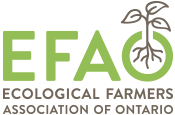History
The Ecological Farmers Association of Ontario (EFAO) came about in 1979 because a Huron County farmer named Thomas Herbert “Herb” Eldridge wanted to share knowledge about ecological farming methods with other farmers.
While the local farm community scoffed at farming without chemicals, a few like-minded growers, notably Alvin Filsinger of Ayton, Ontario, served as a catalyst for this fledgling community. Filsinger connected Eldridge with a small informal network of ecological growers, and by 1978 there were 20 names on his list – enough to start a group. In early 1979 Eldridge organized the group’s charter meeting at the Linwood Community Centre, where he and soil specialist Joe Smillie talked about soil and crop rotations. There was no agenda, no program, no minute keeper, and people brought bagged lunches.
At the end of the day everyone in attendance agreed that they should create an association that would provide opportunities for farmers to share and develop their knowledge about ecological farming practices: the Natural Farmers Association (NFA). Eldridge became the first president, membership secretary and newsletter editor.
There was an informal board of directors that served to suggest farm tours and other educational opportunities. The membership fee was $5, and there was an annual meeting and conference, quarterly newsletters, and at least one farm tour that covered practices such as soil, green manures, composting, cover crops, livestock management, conservation practices, and others.
By 1982, there were approximately 50 members of the NFA, largely in mid-western Ontario. But in that same year, Eldridge sold his farm (due to personal reasons) and the NFA almost folded. Then in 1983, Lawrence and Mathilde Andres, Tiverton-based dairy and cash crop farmers originally from Switzerland, stepped up as president, and newsletter editor/treasurer, respectively. While the NFA had been largely inactive, the Andres family brought it back to life with the publication of the first illustrated, stapled booklet newsletter.
Also, that year the NFA organized a joint forum at the Ethel Central School with David Reibling of Oak Manor Farms in Tavistock. The chief organizer was Tomas Nimmo, who was responsible for organizing the annual Guelph Organic Conference until 2020. The program was based on topics related to soil and crops. Between 120 and 150 people attended. This conference is widely credited for revitalizing and consolidating the ecological farming movement in Ontario.
By the winter of 1983/84, the NFA changed its name to the Ecological Farmers Association of Ontario, with approximately 145 members. In 1985, the Board developed EFAO’s Statement of Purpose, which outlined why the association was first established in 1979:
To develop and provide programs promoting the practice and advancement of ecological agriculture which maintains and enhances the health of the soil, water, crops, livestock and the diversity of the environment.
To educate and increase the public’s understanding of ecological methods, like soil tillage, green manures, cover crops, composting, crop rotations, soil erosion control, and conservation practices by offering courses, seminars, conferences, farm tours, meetings and publishing a newsletter, and by collecting, researching and disseminating information on this topic to the general public.
To bring together people who are concerned about ecological agriculture so they can share experiences, support each other and create community.
The spirit of this purpose is still the foundation of EFAO’s mission today. You can read our full history in Caring for the Land by Diane Baltaz.
In recent years, the EFAO newsletter has evolved into a fully-fledged magazine. A sampling of EFAO’s newsletters over the decades can be found on this page. Contact us for copies of specific editions of the print newsletter from years past.

